Auditing and Assurance Assignment - Finance Module
VerifiedAdded on 2020/04/15
|7
|909
|36
Homework Assignment
AI Summary
This document presents a comprehensive solution to an Auditing and Assurance assignment, addressing key aspects of the auditing process. The assignment covers various topics, including the procedures an auditor must follow during a physical inventory count, emphasizing the importance of controlling for double-counting and ensuring the accuracy and completeness of the count. It also explores the inherent risk factors involved in assessing intangible assets, highlighting the complexity of accounting rules and the judgments required in valuation. Furthermore, the assignment details the analytical procedures used in auditing property, plant, and equipment, such as ratio and trend analysis, and explains how these procedures help identify deviations in asset values. Finally, it discusses the substantive analytical procedures used in auditing the income statement, including the evaluation of income statement presentation and the assessment of account balances, emphasizing the identification of unusual transactions and the use of financial ratios to study relationships between financial statement amounts.
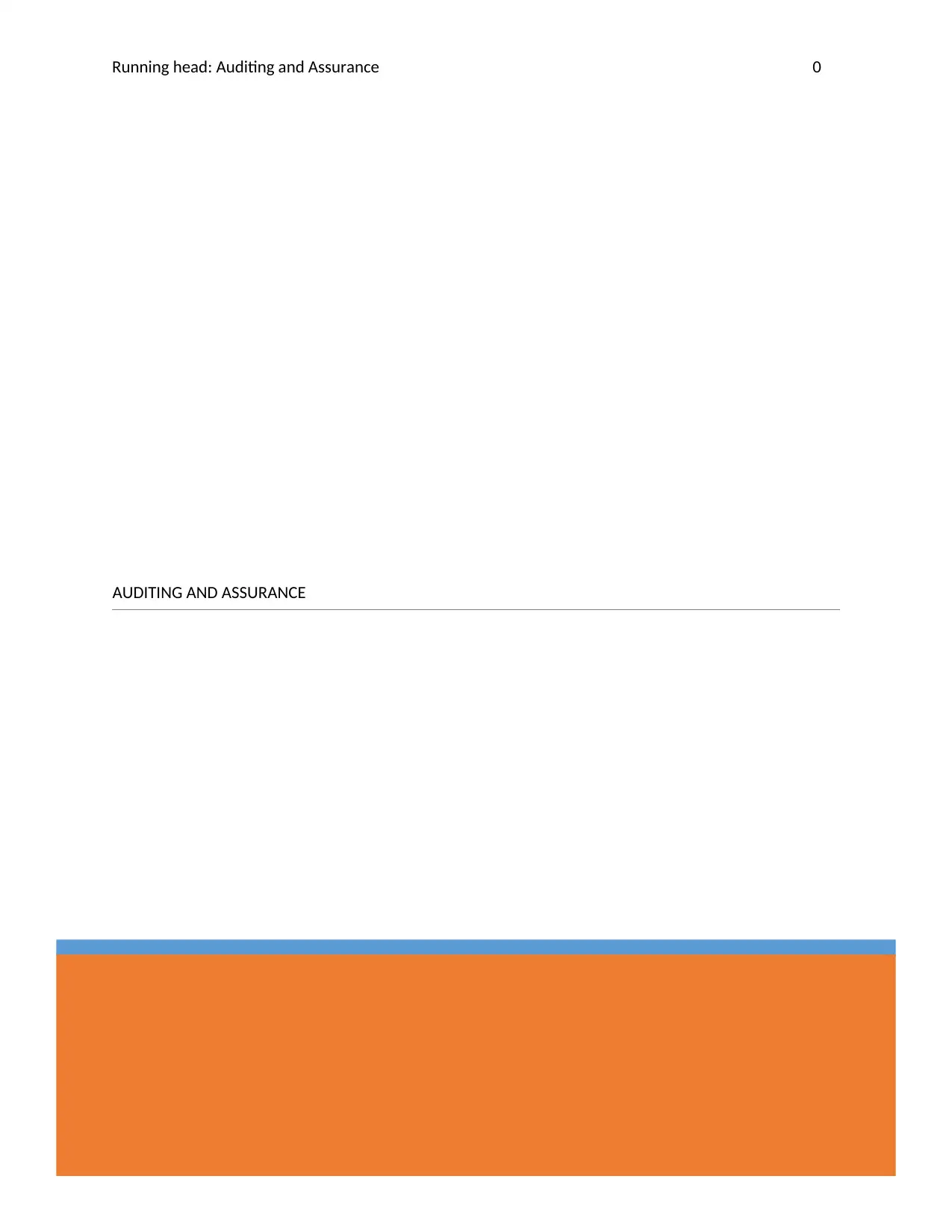
Running head: Auditing and Assurance 0
AUDITING AND ASSURANCE
AUDITING AND ASSURANCE
Paraphrase This Document
Need a fresh take? Get an instant paraphrase of this document with our AI Paraphraser
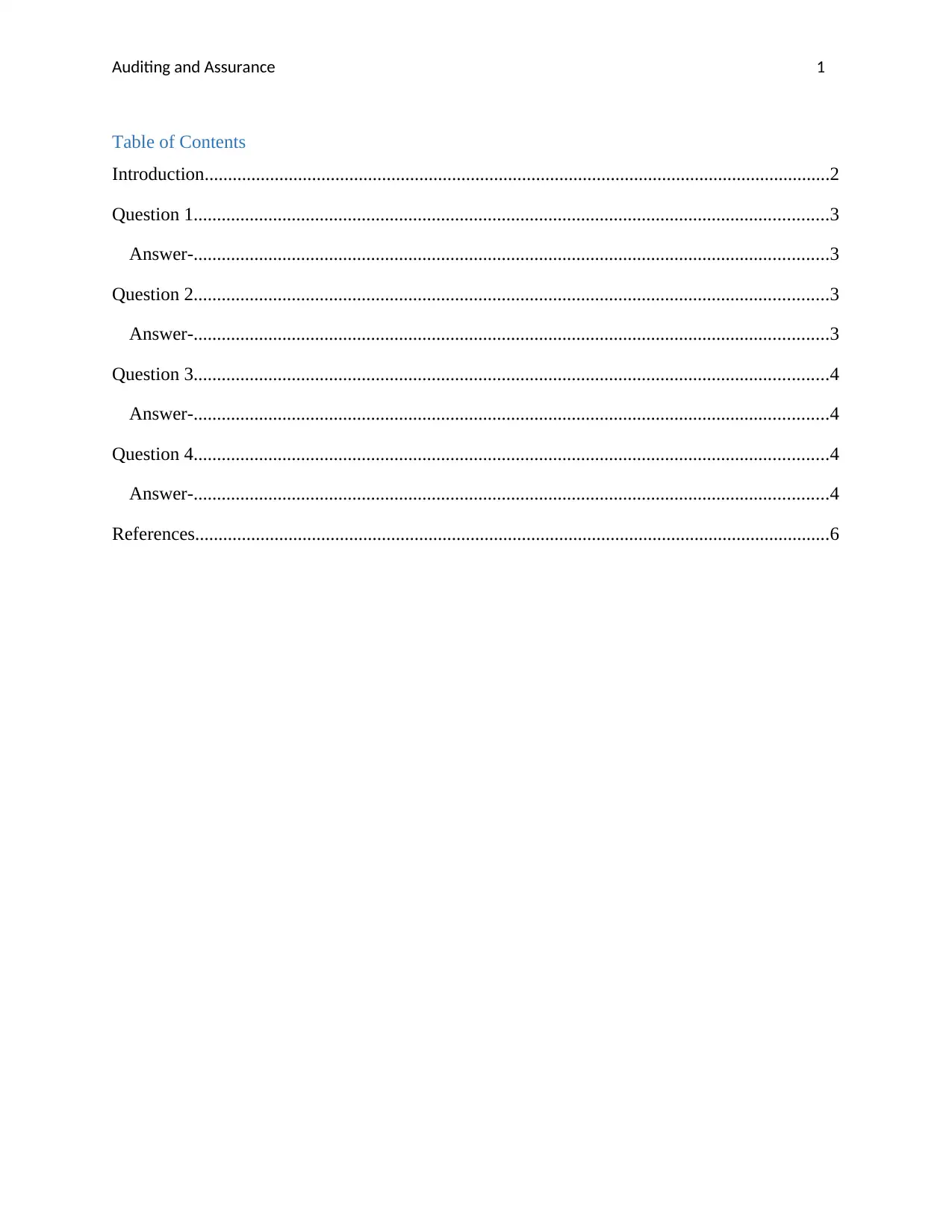
Auditing and Assurance 1
Table of Contents
Introduction......................................................................................................................................2
Question 1........................................................................................................................................3
Answer-........................................................................................................................................3
Question 2........................................................................................................................................3
Answer-........................................................................................................................................3
Question 3........................................................................................................................................4
Answer-........................................................................................................................................4
Question 4........................................................................................................................................4
Answer-........................................................................................................................................4
References........................................................................................................................................6
Table of Contents
Introduction......................................................................................................................................2
Question 1........................................................................................................................................3
Answer-........................................................................................................................................3
Question 2........................................................................................................................................3
Answer-........................................................................................................................................3
Question 3........................................................................................................................................4
Answer-........................................................................................................................................4
Question 4........................................................................................................................................4
Answer-........................................................................................................................................4
References........................................................................................................................................6
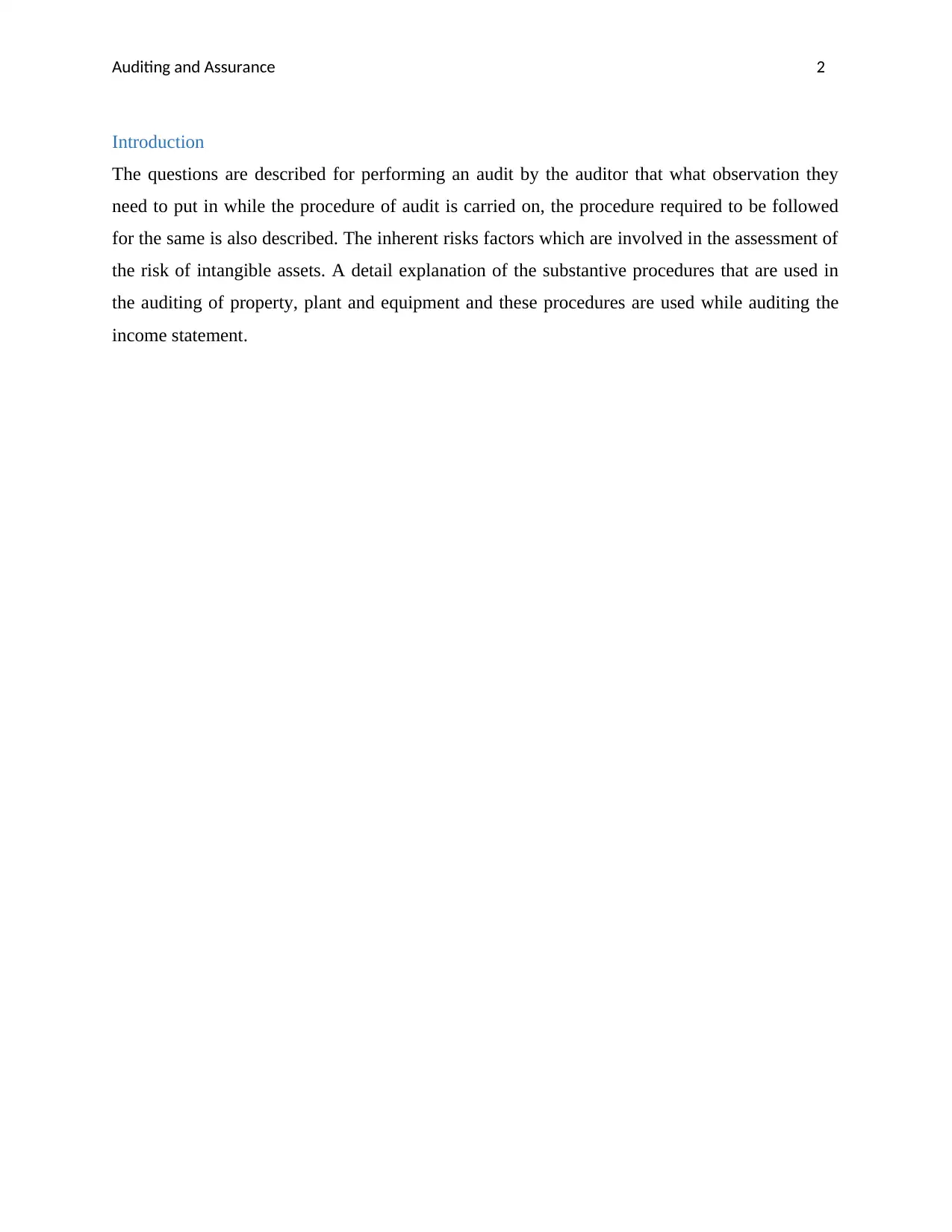
Auditing and Assurance 2
Introduction
The questions are described for performing an audit by the auditor that what observation they
need to put in while the procedure of audit is carried on, the procedure required to be followed
for the same is also described. The inherent risks factors which are involved in the assessment of
the risk of intangible assets. A detail explanation of the substantive procedures that are used in
the auditing of property, plant and equipment and these procedures are used while auditing the
income statement.
Introduction
The questions are described for performing an audit by the auditor that what observation they
need to put in while the procedure of audit is carried on, the procedure required to be followed
for the same is also described. The inherent risks factors which are involved in the assessment of
the risk of intangible assets. A detail explanation of the substantive procedures that are used in
the auditing of property, plant and equipment and these procedures are used while auditing the
income statement.
⊘ This is a preview!⊘
Do you want full access?
Subscribe today to unlock all pages.

Trusted by 1+ million students worldwide
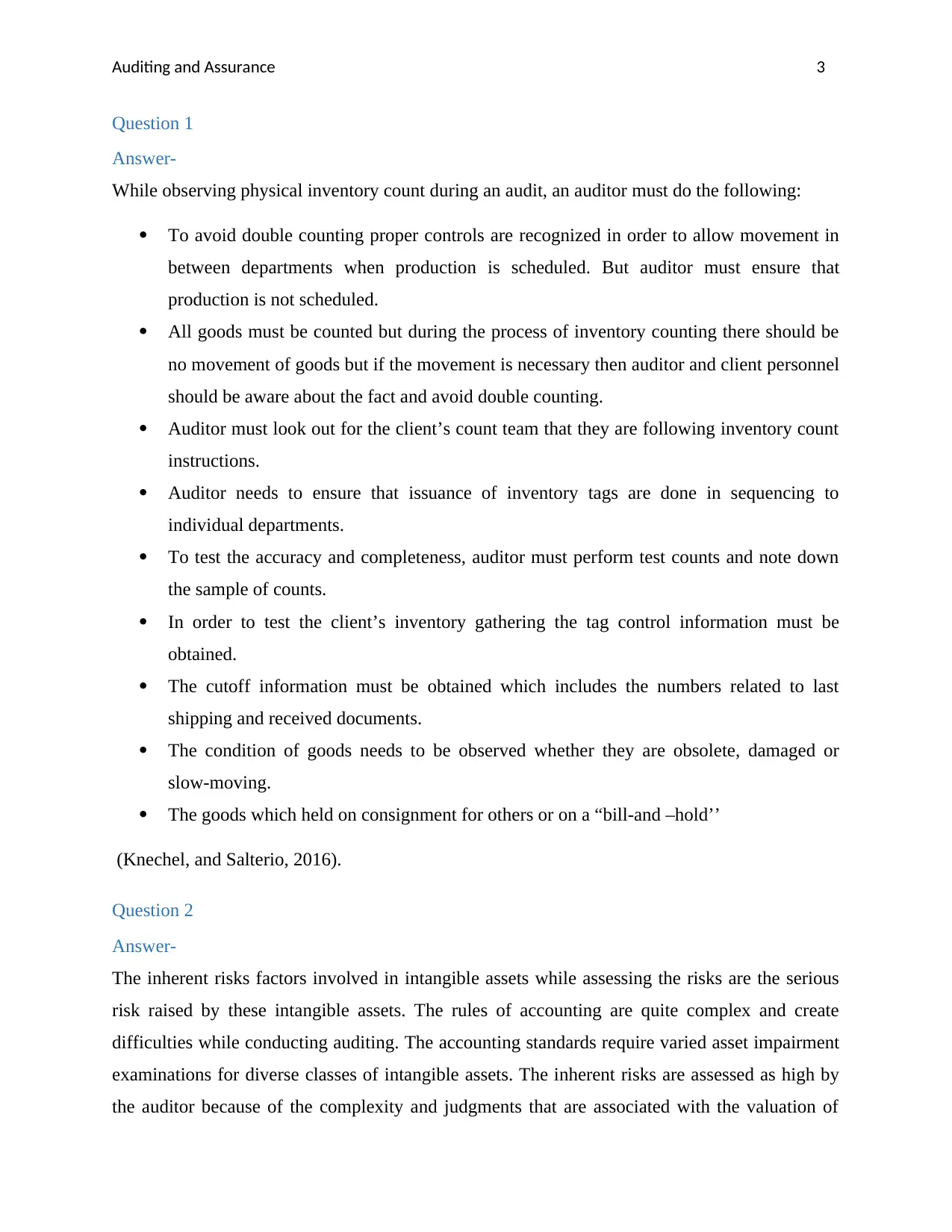
Auditing and Assurance 3
Question 1
Answer-
While observing physical inventory count during an audit, an auditor must do the following:
To avoid double counting proper controls are recognized in order to allow movement in
between departments when production is scheduled. But auditor must ensure that
production is not scheduled.
All goods must be counted but during the process of inventory counting there should be
no movement of goods but if the movement is necessary then auditor and client personnel
should be aware about the fact and avoid double counting.
Auditor must look out for the client’s count team that they are following inventory count
instructions.
Auditor needs to ensure that issuance of inventory tags are done in sequencing to
individual departments.
To test the accuracy and completeness, auditor must perform test counts and note down
the sample of counts.
In order to test the client’s inventory gathering the tag control information must be
obtained.
The cutoff information must be obtained which includes the numbers related to last
shipping and received documents.
The condition of goods needs to be observed whether they are obsolete, damaged or
slow-moving.
The goods which held on consignment for others or on a “bill-and –hold’’
(Knechel, and Salterio, 2016).
Question 2
Answer-
The inherent risks factors involved in intangible assets while assessing the risks are the serious
risk raised by these intangible assets. The rules of accounting are quite complex and create
difficulties while conducting auditing. The accounting standards require varied asset impairment
examinations for diverse classes of intangible assets. The inherent risks are assessed as high by
the auditor because of the complexity and judgments that are associated with the valuation of
Question 1
Answer-
While observing physical inventory count during an audit, an auditor must do the following:
To avoid double counting proper controls are recognized in order to allow movement in
between departments when production is scheduled. But auditor must ensure that
production is not scheduled.
All goods must be counted but during the process of inventory counting there should be
no movement of goods but if the movement is necessary then auditor and client personnel
should be aware about the fact and avoid double counting.
Auditor must look out for the client’s count team that they are following inventory count
instructions.
Auditor needs to ensure that issuance of inventory tags are done in sequencing to
individual departments.
To test the accuracy and completeness, auditor must perform test counts and note down
the sample of counts.
In order to test the client’s inventory gathering the tag control information must be
obtained.
The cutoff information must be obtained which includes the numbers related to last
shipping and received documents.
The condition of goods needs to be observed whether they are obsolete, damaged or
slow-moving.
The goods which held on consignment for others or on a “bill-and –hold’’
(Knechel, and Salterio, 2016).
Question 2
Answer-
The inherent risks factors involved in intangible assets while assessing the risks are the serious
risk raised by these intangible assets. The rules of accounting are quite complex and create
difficulties while conducting auditing. The accounting standards require varied asset impairment
examinations for diverse classes of intangible assets. The inherent risks are assessed as high by
the auditor because of the complexity and judgments that are associated with the valuation of
Paraphrase This Document
Need a fresh take? Get an instant paraphrase of this document with our AI Paraphraser
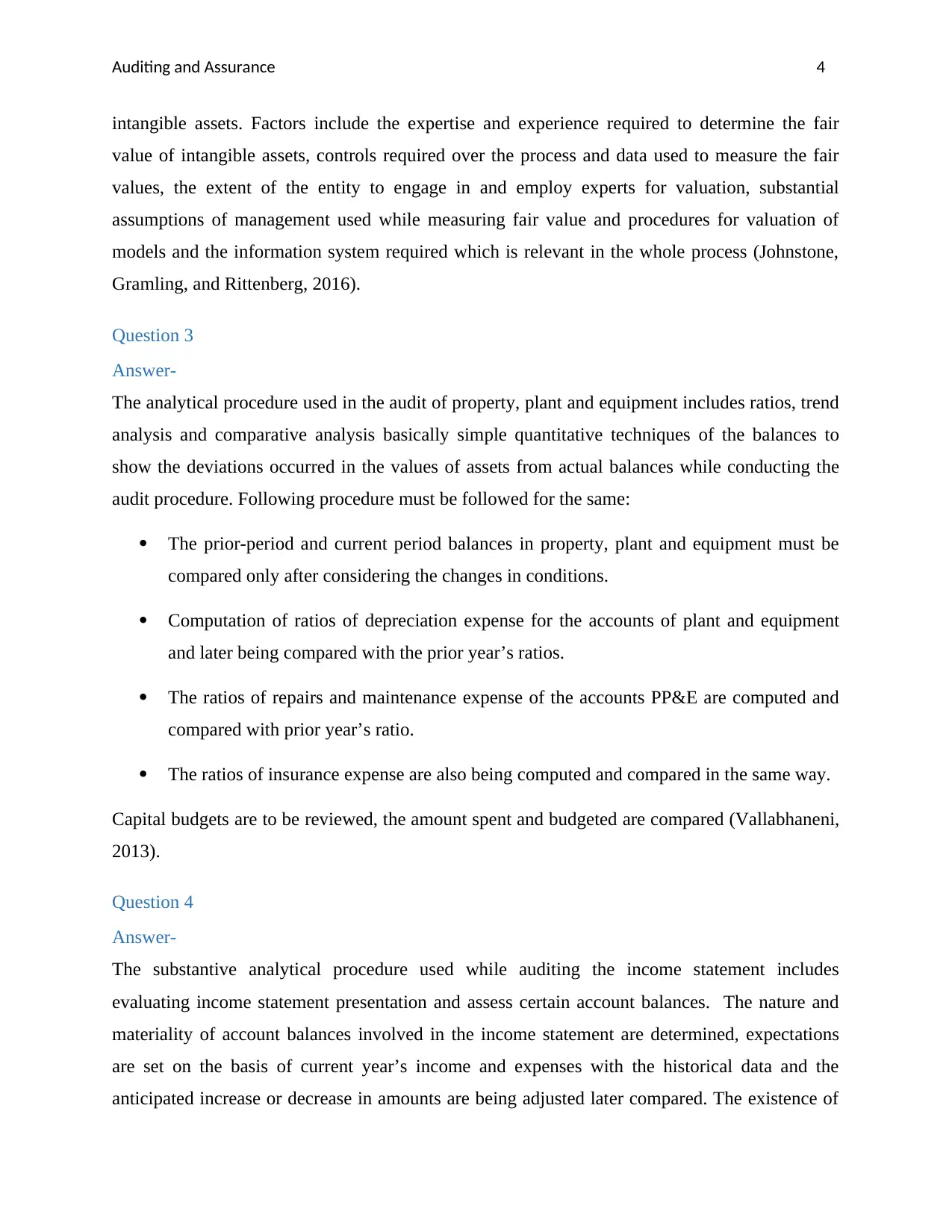
Auditing and Assurance 4
intangible assets. Factors include the expertise and experience required to determine the fair
value of intangible assets, controls required over the process and data used to measure the fair
values, the extent of the entity to engage in and employ experts for valuation, substantial
assumptions of management used while measuring fair value and procedures for valuation of
models and the information system required which is relevant in the whole process (Johnstone,
Gramling, and Rittenberg, 2016).
Question 3
Answer-
The analytical procedure used in the audit of property, plant and equipment includes ratios, trend
analysis and comparative analysis basically simple quantitative techniques of the balances to
show the deviations occurred in the values of assets from actual balances while conducting the
audit procedure. Following procedure must be followed for the same:
The prior-period and current period balances in property, plant and equipment must be
compared only after considering the changes in conditions.
Computation of ratios of depreciation expense for the accounts of plant and equipment
and later being compared with the prior year’s ratios.
The ratios of repairs and maintenance expense of the accounts PP&E are computed and
compared with prior year’s ratio.
The ratios of insurance expense are also being computed and compared in the same way.
Capital budgets are to be reviewed, the amount spent and budgeted are compared (Vallabhaneni,
2013).
Question 4
Answer-
The substantive analytical procedure used while auditing the income statement includes
evaluating income statement presentation and assess certain account balances. The nature and
materiality of account balances involved in the income statement are determined, expectations
are set on the basis of current year’s income and expenses with the historical data and the
anticipated increase or decrease in amounts are being adjusted later compared. The existence of
intangible assets. Factors include the expertise and experience required to determine the fair
value of intangible assets, controls required over the process and data used to measure the fair
values, the extent of the entity to engage in and employ experts for valuation, substantial
assumptions of management used while measuring fair value and procedures for valuation of
models and the information system required which is relevant in the whole process (Johnstone,
Gramling, and Rittenberg, 2016).
Question 3
Answer-
The analytical procedure used in the audit of property, plant and equipment includes ratios, trend
analysis and comparative analysis basically simple quantitative techniques of the balances to
show the deviations occurred in the values of assets from actual balances while conducting the
audit procedure. Following procedure must be followed for the same:
The prior-period and current period balances in property, plant and equipment must be
compared only after considering the changes in conditions.
Computation of ratios of depreciation expense for the accounts of plant and equipment
and later being compared with the prior year’s ratios.
The ratios of repairs and maintenance expense of the accounts PP&E are computed and
compared with prior year’s ratio.
The ratios of insurance expense are also being computed and compared in the same way.
Capital budgets are to be reviewed, the amount spent and budgeted are compared (Vallabhaneni,
2013).
Question 4
Answer-
The substantive analytical procedure used while auditing the income statement includes
evaluating income statement presentation and assess certain account balances. The nature and
materiality of account balances involved in the income statement are determined, expectations
are set on the basis of current year’s income and expenses with the historical data and the
anticipated increase or decrease in amounts are being adjusted later compared. The existence of
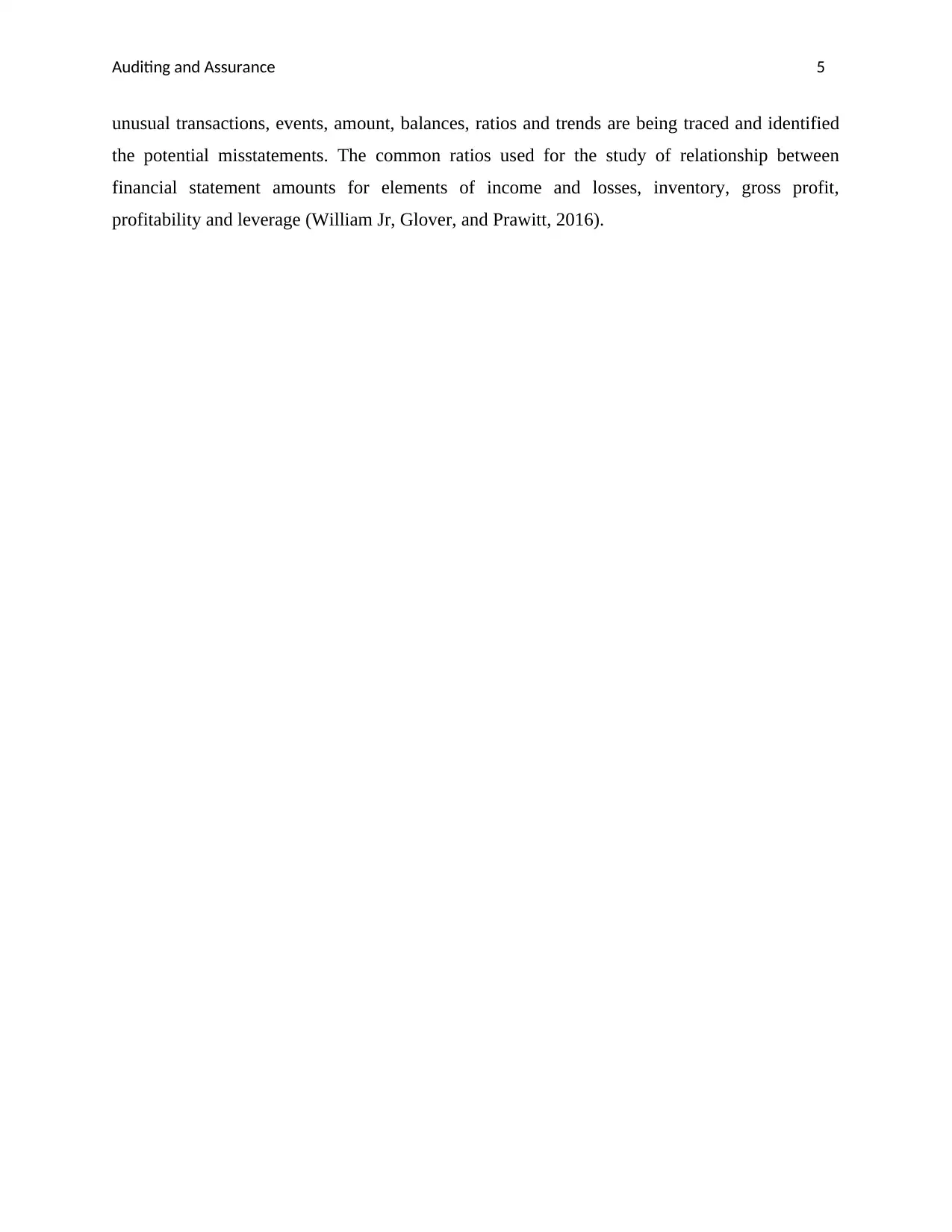
Auditing and Assurance 5
unusual transactions, events, amount, balances, ratios and trends are being traced and identified
the potential misstatements. The common ratios used for the study of relationship between
financial statement amounts for elements of income and losses, inventory, gross profit,
profitability and leverage (William Jr, Glover, and Prawitt, 2016).
unusual transactions, events, amount, balances, ratios and trends are being traced and identified
the potential misstatements. The common ratios used for the study of relationship between
financial statement amounts for elements of income and losses, inventory, gross profit,
profitability and leverage (William Jr, Glover, and Prawitt, 2016).
⊘ This is a preview!⊘
Do you want full access?
Subscribe today to unlock all pages.

Trusted by 1+ million students worldwide
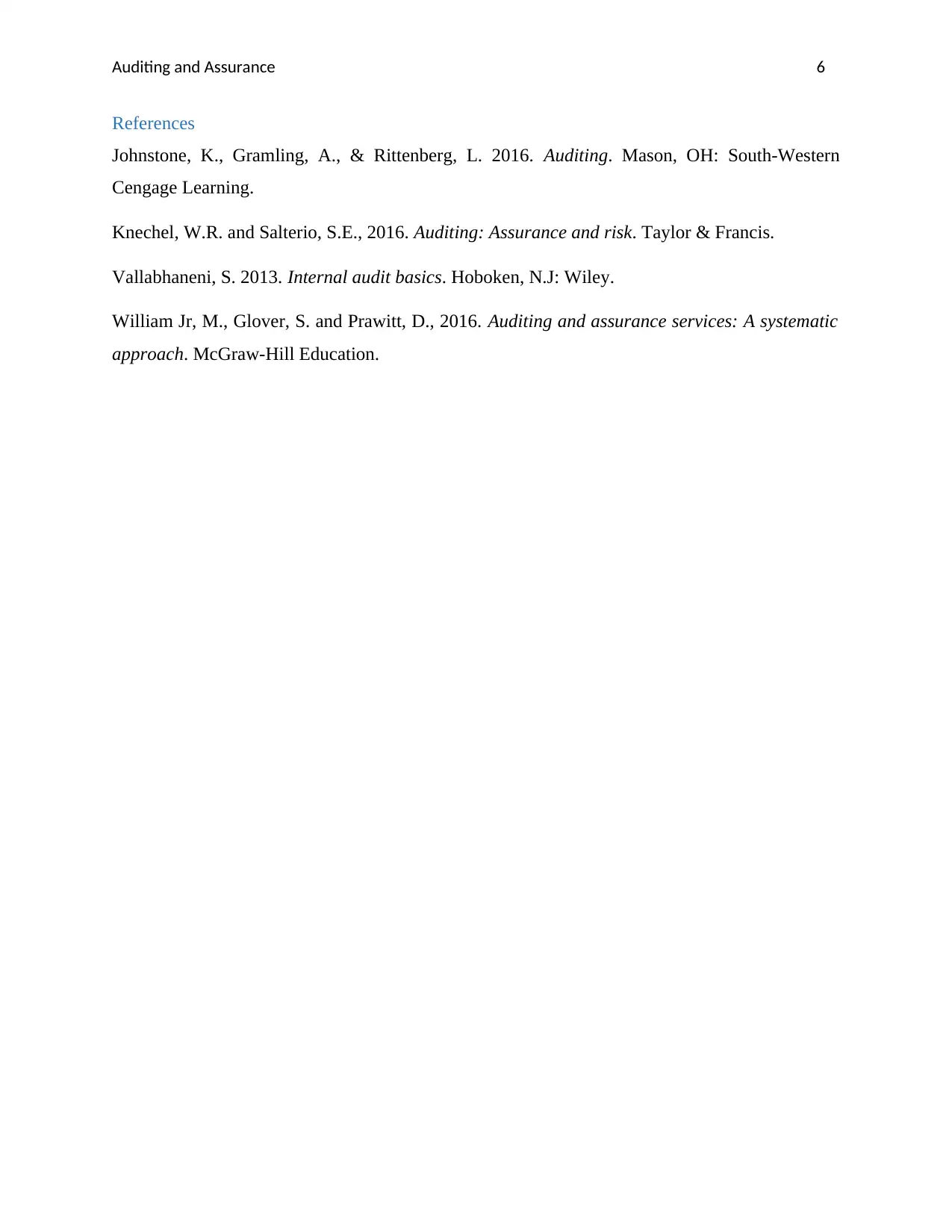
Auditing and Assurance 6
References
Johnstone, K., Gramling, A., & Rittenberg, L. 2016. Auditing. Mason, OH: South-Western
Cengage Learning.
Knechel, W.R. and Salterio, S.E., 2016. Auditing: Assurance and risk. Taylor & Francis.
Vallabhaneni, S. 2013. Internal audit basics. Hoboken, N.J: Wiley.
William Jr, M., Glover, S. and Prawitt, D., 2016. Auditing and assurance services: A systematic
approach. McGraw-Hill Education.
References
Johnstone, K., Gramling, A., & Rittenberg, L. 2016. Auditing. Mason, OH: South-Western
Cengage Learning.
Knechel, W.R. and Salterio, S.E., 2016. Auditing: Assurance and risk. Taylor & Francis.
Vallabhaneni, S. 2013. Internal audit basics. Hoboken, N.J: Wiley.
William Jr, M., Glover, S. and Prawitt, D., 2016. Auditing and assurance services: A systematic
approach. McGraw-Hill Education.
1 out of 7
Related Documents
Your All-in-One AI-Powered Toolkit for Academic Success.
+13062052269
info@desklib.com
Available 24*7 on WhatsApp / Email
![[object Object]](/_next/static/media/star-bottom.7253800d.svg)
Unlock your academic potential
Copyright © 2020–2025 A2Z Services. All Rights Reserved. Developed and managed by ZUCOL.




